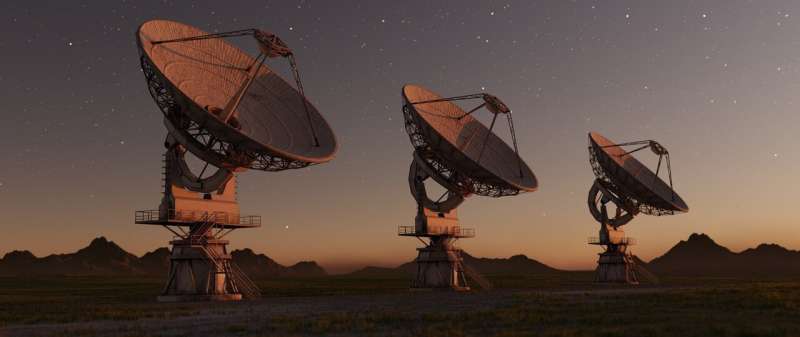This article has been reviewed according to Science X's editorial process and policies. Editors have highlighted the following attributes while ensuring the content's credibility:
fact-checked
peer-reviewed publication
trusted source
proofread
Researchers reveal statistical properties of dispersion measure, waiting time on repeating fast radio burst

Repeating fast radio bursts (FRBs) are mysterious radio transient sources in the universe that emit a repeating radio pulse lasting for a few milliseconds. Plasma lensing is the cold, non-magnetized, and inhomogeneous plasma cloud in cosmic space, which can refract the radio signal as images with frequency-dependent properties, such as the frequency-dependent dispersion measure (DM).
The waiting time, the interval between two adjacent bursts within an observational campaign, is also an important parameter for a repeating FRB. Thus, the statistical properties on the multi-frequency DMs and waiting times of a repeating FRB can unveil the lensing effects in the propagation path.
Recently, Wang Yubin, a Ph.D. candidate at the Xinjiang Astronomical Observatory of the Chinese Academy of Sciences, under the guidance of his supervisor Dr. Zhou Xia, and his collaborators, sorted out the multi-frequency observation data of repeating FRBs, and studied the statistical characteristics of DM and the waiting time of FRB180916.J0158+65 (FRB 180916 for short).
The study was published in Monthly Notices of the Royal Astronomical Society on June 27.
The researchers found that the frequency-dependent two-component Gaussian function could fit DM, and waiting time was a discontinuous bimodal distribution. After the statistical analysis of the relevance of three parameters with the waiting time and observed frequencies, they also identified that variations in the widths, fluences, and peak density fluxes of bursts might be contributed by some external mechanisms.
In addition, they compared the delay time due to lensing effects with the waiting time in the left distribution and the delay time induced by frequency-dependent DM. Results indicated that FRB 180916 might be suffering from the plasma lensing effects in the propagation path. The high mass X-ray binary scenario was more suitable for its origin after discussing many possible models to produce bursts.
More information: Yu-Bin Wang et al, Statistical properties and lensing effect on the repeating fast radio burst FRB 180916.J0158+65, Monthly Notices of the Royal Astronomical Society (2023). DOI: 10.1093/mnras/stad1922
Journal information: Monthly Notices of the Royal Astronomical Society
Provided by Chinese Academy of Sciences





















